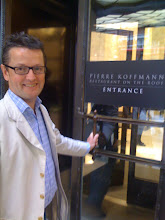
Wine and food matching never excites as much debate as when the food in question is cheese. It is true that a corner of mousetrap or a wedge of supermarket Brie will take the rough edges off a glass of plonky red but great cheese deserves decent wine and the most pleasurable combination will often be with a white (not to mention a beer, cider, sherry & port, or the occasional spirit).
The problem in red wine is often the tannin which can clash with the fat in cheese, particularly the soft varieties. And, the salt in cheese goes very well with the naturally higher acidity found in most whites.
The French especially have a tendency to serve their best red wines with the cheese and many a fragile mature red Burgundy or thin old Claret is laid waste by a board groaning and reeking with impossibly strong, runny, salty, acidic cheeses of which there are hundreds in France. Far better really to serve just one cheese in perfect condition and match it with the appropriate wine. And if in doubt about which wine then sometimes local goes with local. In this case, Munster cheese from Alsace matched with white Alsatian Gewürztraminer.
The French especially have a tendency to serve their best red wines with the cheese and many a fragile mature red Burgundy or thin old Claret is laid waste by a board groaning and reeking with impossibly strong, runny, salty, acidic cheeses of which there are hundreds in France. Far better really to serve just one cheese in perfect condition and match it with the appropriate wine. And if in doubt about which wine then sometimes local goes with local. In this case, Munster cheese from Alsace matched with white Alsatian Gewürztraminer.
Munster is a strong, 'wet rind', pooey cheese which demolishes most wines in its path. Here however, the highish alcohol, luscious texture, residual sugar and very pronounced flavour of the wine (think lychees, rosewater, and a bag full of makeup) manages to match the cheese and create some harmony in spite of the seeming odds.
Occasionally Munster impregnated with cumin is sold. This centuries-old practice came about as an aid to digestion (that well known digestif Kümmel is based on cumin) and again the aromatic spice matches the perfume of the wine (gewürz actually means spice in German) and the monster pong of the cheese. Caraway seeds served separately are also traditional. I discovered this at that Alsatian temple of gastronomy, l'Auberge de l'Ill, where the cheese course was made up of a plate of Munster in various guises including mini soufflé, mini croque monsieur, mini aumônière, fresh, solid and runny, and in the middle a bowl of caraway seeds, and on the side, a glass of fragrant, slightly sweet, vendanges tardives (late harvest), Gewürz. Perfect.











